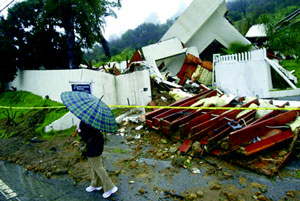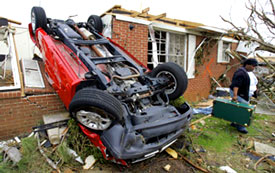
(FinalCall.com) – While the threats of Iraq’s weapons of mass destruction have been proven null and void, America does have to contend with the current weather of mass destruction that is devastating lives and property from coast to coast.
The number of lives lost is rising, costs are mounting, and the weather remains a terror that neither America’s money, might nor muscle can contain.
Rain rules
From Ohio to West Virginia to Kentucky, rain is ruling–and ruining–the land, causing electrical outages, flooding that has people searching for higher ground, and schools closing.
The clean up has begun in central and eastern Ohio, after intense flooding forced nearly 6,500 residents of three counties to escape the raging waters last week. As residents make their return home, the rest of the state continues to battle the dangers of snowstorms.
After a week of high water and flooding, the rivers of central and southern Indiana are slowly trickling down, although most still remain above their flood range. After a storm hit the state last week, The Wabash River crested close to 27 feet, while its normal flood range is 14 feet, according to the National Weather Service.
The rains have also caused a string of deaths from Michigan to Oklahoma. Gale warnings and flood watches are keeping residents on the northern West Coast at bay, while snowstorms have lifted the Rogue River Basin in Oregon from drought levels to normal within the past three weeks. Christmas 2004 saw the snowpack in the Oregon mountains less than 30 percent the average, but now the federal Natural Resources Conservation Service is reporting the snow-water at 78 percent of the average, and 83 percent overall precipitation.
Strange rain is becoming the norm. Look at the weather right after America attacked Iraq March 2003. According to the National Climatic Data Center, weather disasters cost $11.2 billion and it has been years since the country faced such devastation.
In early April 2003, severe storms and large hail fell over the southern plains and lower Mississippi valley, with Texas the hardest hit.
In May 2003, the month President Bush announced the end of combat in Iraq, tornadoes hit the Midwest, the Mississippi, Ohio and Tennessee valleys and portions of the southeast. They set a modern record one-week total of approximately 400 tornadoes reported.
From late October to early November 2003, dry weather and high winds resulted in wildfires in Southern California. More than 743,000 acres of brush and timber burned destroying over 3,700 homes.
This year, around the country, an artic air blast sank the entire contiguous 48 states into the deep freeze during the month of January.
Chill out
There’s cold–and then there’s bitter cold. An arctic freeze has now settled over the eastern part of the country. In the Midwest, thermometers are reading below-zero, but sank to freezing in regions around the Gulf of Mexico.
On Jan. 17, the northern part of the state chilled down to 54 degrees below zero, approaching its record of 60 degrees below. Residents in the “Nation’s Icebox”–International Falls–felt the severity of the area’s nickname as the temp fell to 44 below, while Babbitt, also in northern Minnesota, faced 51 degrees below zero.
This winter, Minnesota is simply freezing at all-time records. In Embarrass on Dec. 24, residents saw the temperatures sink to 42 degrees below zero, the coldest reading in any of the states–including Alaska.
From killer hurricanes to killer avalanches
In 2004, nine land-falling tropical systems affected the U.S. including six hurricanes, three of which were classified as major on the Saffir-Simpson Scale of hurricane intensity. Four of the six hurricanes affected Florida, making it the only state since 1886 to sustain the impact of four hurricanes in one season. (Texas also had four hurricanes in 1886.)
Hurricane Charley in August was the strongest hurricane (category 4 at landfall) to strike the U.S. since Andrew in 1992 and caused an estimated $14 billion in damage. Hurricanes Frances, Ivan and Jeanne quickly followed Charley in September.
The 2004 hurricane season cost the U.S. an estimated $42 billion, the most costly season on record, leaving 152 dead. That record has been calculated back to 1900.
In addition to Florida, hurricanes affected Georgia, South Carolina, North Carolina, Virginia, Maryland, Delaware, New Jersey, Pennsylvania, New York, Puerto Rico, Alabama, Louisiana, Mississippi, West Virginia, Tennessee, Kentucky and Ohio.

On Jan. 14, according to eyewitness accounts, between two and five people wandered into the off-limits backcountry of Utah’s Park City in the Wasatch Mountains, about 30 miles east of Salt Lake City, where an avalanche covered them with over 30 feet of snow.
Summit County Sheriff David Edmunds told reporters that the area was out of bounds and that the people ignored the signs at their own peril.
“They had gone under the ropes, actually passed numerous signs indicating they were leaving resort property and going into an area where there was no avalanche control,” he said.
The potential deaths of these missing people have contributed to this being one of the deadliest winters for avalanches in Utah. So far, six people have been killed. This includes two people who died Jan. 9 in separate avalanches in the central part of the state.
Heavy snowfall contributed to this avalanche. A Utah meteorologist told CNN.com that the snow that had fallen in the region since late 2004 was heavy–about eight to 10 inches of snow per inch of water. There also had been 50 mph to 90 mph-plus winds, which created deep drifts.
Most of the 10,000 avalanches per year occur in the backcountry, according to the Forest Service’s Utah Avalanche Center. About 100 of those involve humans. Avalanches kill more people than any other natural hazard.












